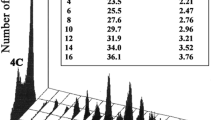Summary
We examined, by the fluorescent halo assay, alterations in the nucleoid structure (structure formed from cells under mild lysis conditions: in non-ionic detergent TritonX-100, 0.0005% and 1.5 mol/1 NaCl) of L5178Y (LY) cell sublines which had been untreated, treated with reducing/chelating agents (ß-mercaptoethanol or sodium diethyl dithiocarbamate (DDTC(Na))) or X-irradiated. These sublines differ in radiation sensitivity: LY-R is more resistant (D 0 = 1.1 Gy) and LY-S more sensitive (D 0 = 0.5 Gy). Halo diameters were measured after cell lysis in the presence of propidium iodide (PI)(0.5 to 50 µg/ml) at pH 6.9 or 9. The maximal DNA unwinding in PI was obtained at 7.5 µg/ml PI, at both pH 6.9 and 9 in both sublines; the maximal halo diameter was larger in LY-S than in LY-R cells. In nucleoids from both sublines DNA could be rewound at higher (10–50 µ/ml) PI concentrations both at pH 6.9 and 9. This ability was impaired by mercaptoethanol or DDTC(Na) (at pH 9) or by X-irradiation, indicating damage and/or alteration in the DNA superhelical structure. The susceptibility to reducing/chelating agents was greater in LY-S than in LY-R nucleoids, pointing to differences in chromatin structure between these sublines. The amount of X-ray-inflicted damage was higher, when measured at pH 9 than at pH 6.9 and was about twice larger in LY-S than in LY-R nucleoids, when the cells were irradiated with the same X-ray dose.
From analogies between the behaviour of nucleoids under the above-described conditions and nucleoid type I and II sedimentation, as examined by Lebkowski and Laemmli (1982) we conclude that damage at two levels of DNA folding is measured at pH 6.9 and 9.
Similar content being viewed by others
References
Alexander P, Mikulski ZB (1961) Mouse lymphoma cells with different radiosensitivities. Nature 195:572–573
Beer JZ, Budzicka E, Niepokojczycka E, Rosiek O, Szumiel I, Walicka M (1983) Loss of tumorigenicity with simultaneous changes in radio- and photosensitivity during in vitro growth of L5178Y murine lymphoma cells. Cancer Res 43:4736–4742
Dijkwel PA, Wenink PW (1986) Structural integrity of the nuclear matrix: differential effects of thiol agents and metal chelators. J Cell Sci 84:53–67
Evans HH, Ricanati M, Horng M-F (1987) Deficiency in DNA repair in mouse lymphoma strain L5178Y-S. Proc Natl Acad Sci USA 84:7562–7566
Flick MB, Warters RL, Yasui LS, Krisch RE (1989) Measurement of radiation-induced DNA damage using gel electrophoresis or neutral filter elution shows an increased frequency of DNA strand breaks after exposure to pH 9.6. Radiat Res 119:452–456
George AM, Cramp WA (1987) The effects of ionizing radiation on structure and function of DNA. Prog Biophys Mot Biol 50:121–169
George AM, Sabovljev SA, Hart LE, Cramp WA, Harris G, Hornsey S (1987) DNA quaternary structure in the radiation sensitivity of human lymphocytes - a proposed role of copper. Br J Cancer 55: [Suppl] VIII 141–144
Jaberaboansari A, Nelson GB, Roti Roti JL, Wheeler KT (1988) Postirradiation alterations of neuronal chromatin structure. Radiat Res 114:94–104
Johanson K-J, Wlodek D, Szumiel I (1982) DNA repair and replication in radiation-sensitive and resistant mouse lymphoma cells γ-irradiated under aerobic and hypoxic conditions. Int J Radiat Biol 41:261–270
Kapiszewska M, Lange CS (1988) The effect of reduced temperature and/or starvation conditions on the radiosensitivity and repair of potentially lethal damage and sublethal damage in L5178Y-R and 5178Y-S cells. Radiat Res 113:458–472
Kapiszewska M, Lange CS (1991) Novobiocin treatment blocks radiation-induced alterations in higher-order DNA structure in L5178Y nucleoids. Radiat Res 127:285–291
Kapiszewska M, Wright WD, Lange CS, Roti Roti JL (1989) DNA supercoiling changes in nucleoids from irradiated L5178Y-S and -R cells. Radiat Res 119:569–575
Lebkowski JS, Laemmli UK (1982) Evidence for two levels of DNA folding in histone-depleted HeLa interphase nuclei. J Mol Biol 156:309–324
Roti Roti JL, Wright WD (1987) Visualization of DNA loops in nucleoids from HeLa cells: Assay for DNA damage and repair. Cytometry 8:461–467
Savage JRK (1990) Mechanisms of chromosome aberrations. In: Mutation and the Environment, Part B. Wiley/Liss, New York, pp 385–396
Thomas EA, Thomas CA Jr (1989) Nucleoid halo expansion indirectly measures DNA damage in single cells. Exp Cell Res 183:149–158
Vogelstein B, Pardoll DM, Coffey DS (1980) Supercoiled loops and eucariotic DNA replication. Cell 22:79–85
Warters RL, Lyons BW (1990) Detection of ionizing radiation-induced DNA double strand breaks by filter elution is affected by nuclear chromatin structure. Radiat Res 124:309–316
Wlodek D, Hittelman WN (1987) The repair of double-strand DNA breaks correlates with the radiosensitivity of L5178Y-S and L5178Y-R cells. Radiat Res 112:146–155
Wlodek D, Hittelman WN (1988a) The relationship of DNA and chromosome damage to survival of synchronized X-irradiated in L5178Y cells. I. Initial damage. Radiat Res 115:550–565
Wlodek D, Hittelman WN (1988b) The relationship of DNA and chromosome damage to survival of synchronized X-irradiated L5178Y cells. II. Repair. Radiat Res 115:566–575
Wlodek D, Olive P (1990) Physical basis for DNA double strand break detection using neutral filter elution. Radiat Res 124:326–333
Author information
Authors and Affiliations
Rights and permissions
About this article
Cite this article
Kapiszewska, M., Szumiel, I. & Lange, C.S. Damage at two levels of DNA folding measured by fluorescent halo technique inX-irradiated L5178Y-R and L5178Y-S cells. Radiat Environ Biophys 31, 311–322 (1992). https://doi.org/10.1007/BF01210211
Received:
Accepted:
Issue Date:
DOI: https://doi.org/10.1007/BF01210211




